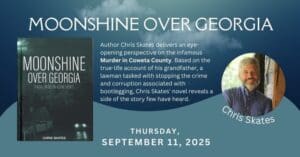On Feb. 9 at their annual Gala, the Newnan Theatre Company formally accepted the script for “Flies at the Well,” to be performed in Newnan’s historic courthouse. In June of 2010, Caroline Abbey, then chair of the Newnan Theatre Company Board of Directors, spearheaded a project that for years had been only a dream: re-enacting the 1948 John Wallace murder trial in the Coweta County courthouse where the original trial took place. With a $20,000 nest egg donated by local businesses, including a generous grant from CharterBank’s Charter Foundation, Abbey issued a request for proposal that invited interested parties to submit plans for an original play.
A script based on Margaret Ann Barnes’ famous “Murder in Coweta County” book was not an option due to the legal complexities of obtaining the rights. So prospective authors had to be prepared to write a completely new drama based on trial records, newspaper accounts and other historical records.
On behalf of Newnan Theatre Company, Abbey received thirty five proposals from authors both local and nationwide. The winning proposal was submitted by Jeff Bishop, then a reporter for the Newnan Times Herald and a historical scholar. Bishop’s version of the story will be more than a trial reenactment; it will be a full-fledged drama and a musical. More readings and revisions are still in the cards, and the actual production date for the play has yet to be determined. “We need to see how audiences who know absolutely nothing about the story will react,” said NTC’s Artistic Director Paul Conroy.
“Musical theater is an American invention,” added Conroy. “It’s our contribution to the world of theater. This is an American story. There have been other musicals about trials in the South, such as ‘Parade’ and These shows played on Broadway. So – we have high hopes for this show. We just don’t want to launch it prematurely.”
Shortly before NTC’s formal acceptance of his script, Caroline Abbey and Joan Doggrell held the following conversation with Bishop.
Doggrell: How do you come to know so much of the history surrounding the “Murder in Coweta County” story?
Bishop: I grew up in Senoia. My family – the Couch family — is from Senoia. In fact, one of my ancestors was an original settler. My mother was one of the first librarians in Senoia, and I remember that when Margaret Ann Barnes’ book was published it was a big event. I was too little to read the book, but I did see the TV movie. We were all excited that Coweta County was going to be on national television.
Another connection for me was Danny Brooks, the grandson of Albert Brooks, one of the field hands whom John Wallace forced to burn Wilson Turner’s body. Danny and I both played trumpet in the Newnan High School band.
I got interested in newspapers when I was in middle school, then high school. We printed our school newspaper, “Smoke Signals,” at the Newnan Times-Herald. That was where Margaret Ann Barnes worked and where her career started. I began working for the Times Herald when I was 16 years old. I started out pushing a broom, but they also let me write. Margaret Ann Barnes and Lewis Grizzard were the two big stars of the newspaper. So I grew up with the story.
Doggrell: What did people have to say about how the book and the TV movie compared with actual events?
Bishop: Some were happy with it and others weren’t. Some said Barnes made too much of a hero of Sheriff Potts. I think for the most part she did a good job of capturing the essence of what happened. Most people were just excited that Coweta County was going to be on television.
Doggrell: I know you had to write the play from scratch. Where did you start doing your research?
Bishop: The place I started, which became the core of what I wrote, was the trial transcript. There are hundreds of pages of testimony and depositions. There are also newspaper accounts – the story was in all the papers, not just locally but statewide and also nationally. So there is a lot of resource material to draw from. You can understand how Margaret Ann Barnes could go into such detail with her book.
My proposal relied very heavily on the trial transcript. My big challenge in revising was to move away from the transcript. I wanted do a play, which is not the same thing as a trial reenactment. So parts of the play are reenactments of bits and pieces of the trial, but as a whole it tries to be a cohesive story.
Doggrell: Of course, anytime you’re putting on a play you’ve got a single location, a stage, but in this case a courthouse. How did you deal with that limitation?
Bishop: That was the big challenge from the very start. I think limitations are the best way to inspire creativity. I knew my play would be very different from the book. In the movie and the book, you can follow the investigation from place to place. You can go to the scene of the crime in Moreland, to Sheriff Potts’ office, Mayhayley Lancaster’s house. The challenge became how to use the courthouse in a way that was not confining. So the way the play unfolds, you start out in the courthouse hearing testimony. But then it diverges bit by bit until in the second act you’re in the woods. The courthouse becomes the forest.
Abbey: Do you think that down the road it will be possible for another theatre – say in Seattle, Washington — to perform this play?
Bishop: As a matter of fact, Paul Conroy wants it to not be bound absolutely to the courthouse so we could take it into the theatre space or even other theatres in other towns. The set would have to mimic a courthouse as a starting point. Then as the play morphs into other scenes, a theatre space might help facilitate the scene changes with lighting, special effects, etc.
Abbey: But the Newnan courthouse is an amazing draw.
Bishop: And that was the guiding force all along: that the play could actually be performed in the courthouse. So all time I was writing, that was front and center in my mind.
Doggrell: I understand that your play will be a musical. Is it going to be like an opera, with every speech sung, or will the music simply be in the background?
Bishop: The musical concept threw some people for a loop. I started off with the whole tradition of sacred harp, which seemed very appropriate to this material. Shaped note singing is an old southern tradition that has spread to other parts of the country. There’s something raw and primal about it which seemed appropriate for this kind of material. It’s very much from the soul. The ambiance and the acoustics of the courthouse remind me a lot of the sound you get in old southern churches. Then I saw that the jurors could serve as a Greek chorus. They would be the singers. But as we reread the play, the singing component expanded to include not just the sacred harp but also Gospel singing, field songs, prison songs, and country songs – what my grandfather called hillbilly music. All these styles are very southern and from that time period.
We’re not just trying to tell the story but to have people emotionally involved in the story. Music has been an integral part of theatre from the beginning. The Greek chorus sang the play. Then the soloist became the first actor, moving apart from the chorus. That evolved to what we think of as theatre now. The jury’s going to be there to listen to the testimony. The Greek chorus served the same purpose of passing judgment and also commenting on the action of the play. I thought that seemed very appropriate for this particular story: something that was visceral, emotional, and deeply traditional as well as very modern.
Abbey: What makes this play more than just another murder story?
Bishop: If this were just a story about a murder – well, how interesting is that? For me personally, what made it resonate was that we had a Deep South where certain people mattered and certain people did not. After this trial, we had a South where maybe it was possible that other people did matter. Sharecroppers mattered. African-Americans mattered. We’re not there yet, but we’re moving towards a different kind of society. This was a step along the way. Just a few years later – in 1954 – the Supreme Court heard the case of Brown versus the Board of Education. This story is kind of a precursor to all that. And it happened right here in Coweta County. It was a very progressive thing to have happened here. That to me is what makes this story different.










Leave a Comment
You must be logged in to post a comment.